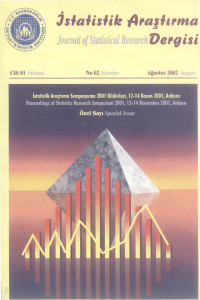Öz
Genel anlamda küme, birbirine benzer gözlemlerin (bireylerin) oluşturduğu topluluktur. Sağlık olaylarında kümeler yer, zaman ya da hem yer hem de zaman içinde olguların (vakaların) sayısında aşırılıklar olduğunda oluşur. Hastalıkların yer ve zaman yapılarının incelenmesi epidemiyolojik araştırmalar ve hastalıkların izlenmesinde önemli bir role sahiptir. Bu kümelenmenin nedenleri incelenerek hastalığın nedenleri (etiyolojisi) ile ilgili yeni hipotezler önerilebilir. Ayrıca, hastalıkların yer ve zamana göre kümelenmeleri belirlenerek yetersiz olan kaynakların daha etkin kullanılması sağlanabilir. Kümelerin oluşturulmasında değişik yöntemler vardır. Bir küme tanımlamak için genel olarak: araştırmada elde edilebilecek verileri, kümeleme tipini ( yer, zaman ya da hem yer hem de zamanda), kümelenmenin olmayacağı beklendiğinde olguların yapısını tanımlayan yokluk hipotezini ve kümelenme olduğunda olguların yapısına karşılık gelen alternatif hipotezi belirlemek gerekir. Bu çalışmada, hastalıkların kümelenmesinde kullanılan yöntemler tanıtılacak ve aynı veri seti üzerinde Knox testi ve yer-zaman scan istatistiği uygulanarak elde edilen sonuçlar karşılaştırılacaktır.
Anahtar Kelimeler
Kaynakça
- JACQUEZ G.M. ve diğeleri. (1996), The Analysis of Disease Clusters, Part I. Infection Control and Hospital Epidemiology; 17 (5): 319-327.
- JACQUEZ G.M. ve diğeleri. (1996), The Analysis of Disease Clusters, Part II. Infection Control and Hospital Epidemiology; 17 (5):385-397.
- KULLDORF M. ve diğerleri. (1998), Evaluating Cluster Alarms: A Space-Time Scan Statistic and Brain Cancer in Los Alamos, New Mexico. American Journal of Public Health; 88: 1377-1380.
- KULLDORF M. ve HJALMARS, U. (1999), The Knox Method and Other Tests For Space-Time Interaction. Biomerics; 55: 544-552.
- MARSHALL R.J. (1991), A Review of Methods for the Statistical Analysis of Spatial Patterns of Disease. Journal of Royal Statistics Society A; 154: 421-441.
- METZ L.M. ve McGuinness S. (1997), Responding to Reported Clusters of Common Diseases: The Case of Multiple Sclerosis. Canadian Journal of Public Health; 88: 277-279.
- WALLENSTEİN S., Gould M.S. ve Kleinman M. (1989), Use of the Scan Statistics to Detect Time-Space Clustering. American Journal of Epidemiology; 130: 1057-1064.
- WALLENSTEİN S. (1980), A Test for Detection of Clustering Over Time. American Journal of Epidemiology; 111: 367-372.
- WALLER, L.A. ve diğerleri. (1995), Detection and Assessment of Clusters of Disease: An Application to Nuclear Power Plant Facilities and Childhood Leukaemia in Sweden. Statistics in Medicine; 14: 3-16.
- WHİTTEMORE A.S., Friend N. ve diğerleri. (1987), Miscellanea a Test to Detect Clusters of Disease. Biometrika; 74: 631-635.
Öz
In general, clusters mean unusual aggregation of similar observations. When there is an excess in the number of cases in space, time or both in time and space, disease clusters are occured in health events. Analysis of space and time patterns of disease have an important role in monitoring disease and epidemiological research. Analyzing the causes of disease clusters, new hypothesis are suggested about the etiology of disease. Moreover, identifying the space and time clustering of disease, sparse sources can be used efficently. There are different methods in defining disease clusters. In order to define a cluster: characterize the data available for the investigation, determine the type of clustering, specify the null hypothesis describing the pattern of cases expected in the absence of clustering and the alternative hypothesis corresponding to the pattern of cases expected under clustering. In this study, methods that used in disease clustering are described and obtained results are compared by using the Knox's test and space-time scan statistics with same data set.
Anahtar Kelimeler
Kaynakça
- JACQUEZ G.M. ve diğeleri. (1996), The Analysis of Disease Clusters, Part I. Infection Control and Hospital Epidemiology; 17 (5): 319-327.
- JACQUEZ G.M. ve diğeleri. (1996), The Analysis of Disease Clusters, Part II. Infection Control and Hospital Epidemiology; 17 (5):385-397.
- KULLDORF M. ve diğerleri. (1998), Evaluating Cluster Alarms: A Space-Time Scan Statistic and Brain Cancer in Los Alamos, New Mexico. American Journal of Public Health; 88: 1377-1380.
- KULLDORF M. ve HJALMARS, U. (1999), The Knox Method and Other Tests For Space-Time Interaction. Biomerics; 55: 544-552.
- MARSHALL R.J. (1991), A Review of Methods for the Statistical Analysis of Spatial Patterns of Disease. Journal of Royal Statistics Society A; 154: 421-441.
- METZ L.M. ve McGuinness S. (1997), Responding to Reported Clusters of Common Diseases: The Case of Multiple Sclerosis. Canadian Journal of Public Health; 88: 277-279.
- WALLENSTEİN S., Gould M.S. ve Kleinman M. (1989), Use of the Scan Statistics to Detect Time-Space Clustering. American Journal of Epidemiology; 130: 1057-1064.
- WALLENSTEİN S. (1980), A Test for Detection of Clustering Over Time. American Journal of Epidemiology; 111: 367-372.
- WALLER, L.A. ve diğerleri. (1995), Detection and Assessment of Clusters of Disease: An Application to Nuclear Power Plant Facilities and Childhood Leukaemia in Sweden. Statistics in Medicine; 14: 3-16.
- WHİTTEMORE A.S., Friend N. ve diğerleri. (1987), Miscellanea a Test to Detect Clusters of Disease. Biometrika; 74: 631-635.
Ayrıntılar
| Birincil Dil | Türkçe |
|---|---|
| Konular | Biyoistatistik |
| Bölüm | Araştırma Makaleleri |
| Yazarlar | |
| Yayımlanma Tarihi | 16 Ağustos 2002 |
| Yayımlandığı Sayı | Yıl 2002 Cilt: 1 Sayı: 2 |

